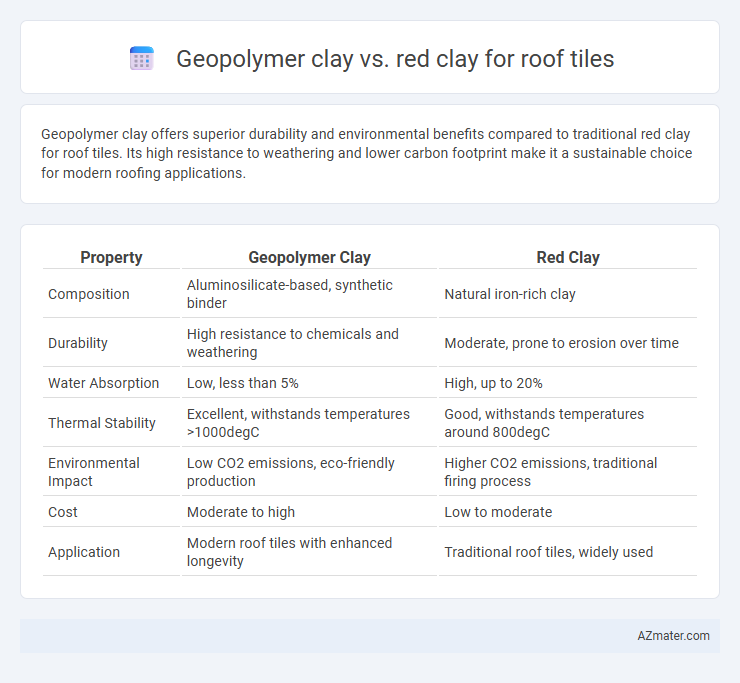Geopolymer clay offers superior durability and environmental benefits compared to traditional red clay for roof tiles. Its high resistance to weathering and lower carbon footprint make it a sustainable choice for modern roofing applications.
Table of Comparison
| Property | Geopolymer Clay | Red Clay |
|---|---|---|
| Composition | Aluminosilicate-based, synthetic binder | Natural iron-rich clay |
| Durability | High resistance to chemicals and weathering | Moderate, prone to erosion over time |
| Water Absorption | Low, less than 5% | High, up to 20% |
| Thermal Stability | Excellent, withstands temperatures >1000degC | Good, withstands temperatures around 800degC |
| Environmental Impact | Low CO2 emissions, eco-friendly production | Higher CO2 emissions, traditional firing process |
| Cost | Moderate to high | Low to moderate |
| Application | Modern roof tiles with enhanced longevity | Traditional roof tiles, widely used |
Introduction to Geopolymer Clay and Red Clay Roof Tiles
Geopolymer clay roof tiles are made from industrial by-products like fly ash and slag, offering enhanced durability, chemical resistance, and lower carbon footprints compared to traditional materials. Red clay roof tiles, crafted from natural red clay rich in iron oxide, provide excellent thermal insulation, weather resistance, and a classic aesthetic preferred in many regions. Both materials differ significantly in composition, environmental impact, and performance, influencing their suitability for modern roofing applications.
Composition and Material Properties
Geopolymer clay roof tiles consist primarily of aluminosilicate materials derived from industrial byproducts mixed with alkaline activators, resulting in a dense, chemically stable matrix with high thermal resistance and low water absorption. In contrast, red clay roof tiles are composed mainly of natural iron-rich silicate minerals that undergo traditional firing, producing porous materials with moderate mechanical strength and higher permeability. Geopolymer tiles offer superior durability and resistance to chemical degradation compared to the more brittle and weather-sensitive red clay counterparts.
Environmental Impact and Sustainability
Geopolymer clay roof tiles offer a lower carbon footprint compared to traditional red clay tiles due to their use of industrial by-products like fly ash, significantly reducing greenhouse gas emissions during production. These tiles exhibit enhanced durability and resistance to weathering, contributing to a longer lifespan and less frequent replacements, which in turn minimizes material waste. Red clay tiles, while naturally abundant, require higher energy for firing at elevated temperatures, resulting in greater environmental impact and reduced sustainability over their lifecycle.
Manufacturing Process Comparison
Geopolymer clay roof tiles are manufactured by combining industrial byproducts like fly ash or slag with alkaline activators, resulting in a chemical curing process at ambient temperatures, which reduces energy consumption. In contrast, red clay roof tiles require extraction of natural clay followed by extensive molding, drying, and firing at high temperatures (typically around 1000degC) to achieve hardness and durability. The geopolymer process offers environmental benefits by minimizing CO2 emissions and raw material usage compared to the traditional high-energy kiln firing in red clay tile production.
Durability and Weather Resistance
Geopolymer clay offers superior durability and weather resistance compared to traditional red clay roof tiles, with enhanced resistance to cracking, water absorption, and freeze-thaw cycles. Its chemical composition provides excellent strength and longevity, making it less susceptible to erosion and color fading under harsh environmental conditions. Red clay tiles, while aesthetically appealing, tend to be more porous and vulnerable to weather-induced damage over time, reducing their lifespan and maintenance efficiency.
Thermal Insulation and Energy Efficiency
Geopolymer clay roof tiles exhibit superior thermal insulation properties compared to traditional red clay tiles, significantly reducing heat transfer and maintaining cooler indoor temperatures. The enhanced energy efficiency of geopolymer clay results from its lower thermal conductivity, which decreases reliance on air conditioning and lowers energy costs. Red clay tiles, while durable, typically have higher thermal conductivity, making them less effective in energy conservation for roofing applications.
Cost Effectiveness and Economic Analysis
Geopolymer clay roofing tiles offer significant cost savings due to lower energy consumption during production compared to traditional red clay tiles, which require higher firing temperatures. Economic analysis shows that geopolymer tiles reduce manufacturing expenses and provide longer durability, decreasing maintenance and replacement costs over time. While initial material costs for geopolymer clay may be slightly higher, the overall lifecycle cost proves more cost-effective than red clay alternatives.
Aesthetic Appeal and Design Flexibility
Geopolymer clay offers superior aesthetic appeal for roof tiles due to its ability to mimic natural stone textures and a wide range of color options, enhancing architectural beauty. Its design flexibility allows for precise molding into intricate shapes and patterns, accommodating custom and modern roof designs more efficiently than traditional red clay. In contrast, red clay tiles provide a classic terracotta look but with limited color variety and less adaptability to innovative or complex roofing styles.
Installation and Maintenance Requirements
Geopolymer clay roof tiles require minimal installation effort due to their lightweight nature and uniform shape, allowing faster placement with reduced structural support compared to traditional red clay tiles. Maintenance for geopolymer tiles is low, as they resist cracking, erosion, and weathering more effectively than red clay, which often demands periodic cleaning, sealing, and replacement of damaged tiles. The durability and weather resistance of geopolymer clay reduce long-term upkeep costs and labor in comparison to the more porous and brittle red clay roofing material.
Conclusion: Choosing the Right Clay for Roof Tiles
Geopolymer clay offers enhanced durability, superior resistance to weathering, and eco-friendly benefits compared to traditional red clay, making it an ideal choice for long-lasting roof tiles. Red clay remains a cost-effective material with proven historical use and natural aesthetic appeal but may require more maintenance over time. Selecting the right clay depends on prioritizing factors such as environmental impact, durability, and budget constraints for optimal roofing performance.

Infographic: Geopolymer clay vs Red clay for Roof tile
 azmater.com
azmater.com